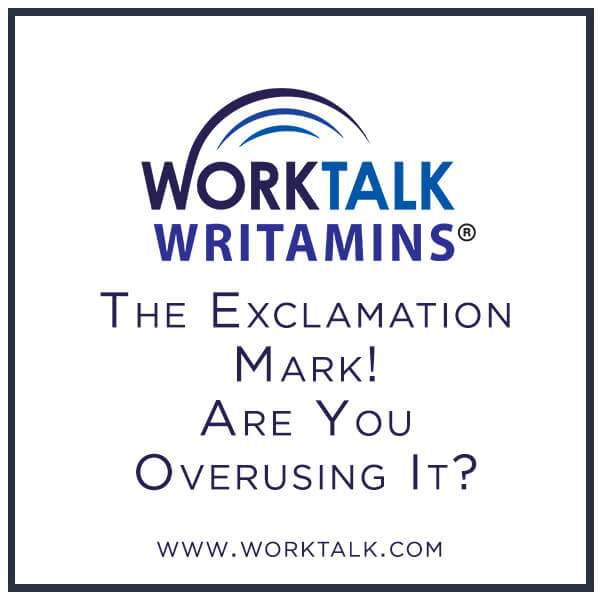Dear John!
We are really excited to be taking this next step with your company!! I know that we are going to be experiencing incredible growth together! Please contact me if there is anything that you need from us!
Looking forward to a great future together!
Robert
Quick: What is your opinion of Robert? Is he a cool-headed professional with whom you can trust your business? Or does he seem like an overenthusiastic hothead whose judgment you doubt?
Dear John,
We are pleased to be taking this next step with your company. I know that we are going to be experiencing incredible growth together. Please contact me if there is anything that you need from us.
Looking forward to a great future together,
Robert
Now, has your estimation of Robert changed? With the exception of one word, the only change was the punctuation. We let go of a slew of exclamation marks.
Exclamations pepper our universe constantly, blooming in business emails, social media postings, and text messages. What happened to making a simple statement? The exclamation mark, which used to be used rarely in business correspondence, is making a comeback. Are we all so much more thrilled than we used to be, or are we getting carried away with a trend toward excessive punctuation?
I hope we’re all just so happy that we can’t curb our enthusiasm, but when I teach business writing, I advise people to be prudent about exclamation marks if they want to maintain a professional tone.
The Case for Using the Exclamation Mark
In contemporary American business discourse, the exclamation mark has become a marker of friendliness and enthusiasm. The problem is that in writing, as in life, people often get too friendly and enthusiastic. And that’s where the problems start. When it comes to this mark of punctuation, less is more.
Nevertheless, the exclamation mark has a place. As always, communication depends on our connection to our readers and on what our readers expect.There are two reasons why I think it is acceptable to loosen up a little on the exclamation marks.
First, business conversations are increasing informal. The days of Dear Sir and To Whom It May Concern are over. Business writing today is brisker and more informal. The whole tone of business dialogue is loosening up in America. (I wouldn’t advise using the informal tone for international writing.) So why not hang out and allow a few exclamation marks?
Second, many people, especially Millennials, use exclamation marks to warm up tone, and they expect the people they converse with to do the same. While we don’t need to mirror everything our correspondents do, in client relationships it pays to make our clients feel at home. And if they write Thank you! in their email to us, it may be appropriate to write You’re welcome! in our reply.
The High Price of Overusing Exclamation Marks
Despite the general loosening of standards, do not use exclamation points with abandon. The person to whom you are writing might not share your enthusiasm. He or she might be more conservative, older, less chirpy than you are.
And those exclamation marks are going to brand you a lightweight. They make you seem flighty and over-excited. Innumerable readers will take you less seriously if you use too many exclamation marks. And you’ll never know it.
All you have is your credibility; if you lose it by showering your reader with exclamations, you can’t get your authority back. Think of a senior person you respect: How often does that person use exclamation marks? Probably not very often.
Instead of an Exclamation Mark
Here’s a novel idea: Use words to show emphasis. Don’t rely on a paltry punctuation point to show your reader that your message is important. That’s what language is for: to convey meaning. And part of conveying that meaning is conveying the importance of what you are writing.
Connect your message to topics that are important to your reader. Paint visual images. As the former head of the National Institutes of Health Bernadine Healy used to say, use strong verbs and short sentences. Then you won’t be so tempted to rely on a punctuation mark to shoulder your meaning.
In short, if you are writing in an informal tone, or if you want to seem friendly, you can sprinkle in an exclamation mark or two. If you need to be more formal and you value your credibility, restrain yourself from raining down exclamation marks.
As Coco Chanel said, “Elegance is refusal.” And refusing to use the exclamation mark may be the most elegant touch you bring to your message.
Resources:

Hubspot created a flowchart showing when to uses an exclamation mark. “Do You Really Need That Exclamation Point?” The short answer is No, you do not really need it.
The Muse takes a slightly more sanguine approach to the exclamation point, but still advises readers to discipline themselves to a single exclamation point in a document.
A Fast Company blog makes the key distinction between emotion and emotional intelligence. Exclamation points show emotion; emotional intelligence may dictate restraint.
A recent Netflix documentary called Explained explores the history and usage of the exclamation point.

I personally use explanation marks when I am annoyed and want to make sure the person I’m writing to understands the temperature of the message and making my displeasure known. Almost the same as using all caps and then emphasing all that “yelling” with an explanation mark or five.. LoL…
So if I received a professional email full of explanation marks it would certainly be questioned..
I enjoyed reading this post, it made me take PAUSE!!! and laugh.. The English language is certainly changing
.
Yes, those exclamation marks can definitely impair a person’s credibility. I’m glad the post made you laugh!